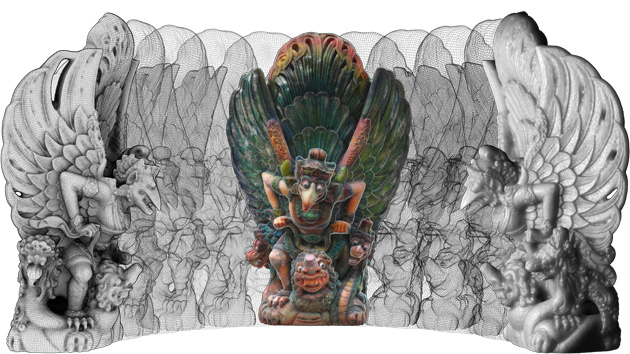Autodesk upgraded its Memento reality capture project from from technology preview to public beta, releasing a cloud-connected Windows desktop app for free download. With the ability to generate and edit two-billion-polygon meshes, Memento is intended to be a powerful but easy-to-use system for creating models that can be displayed on interactive 3D websites, fabricated using 3D printing technology, or employed in VFX and animation projects.
Tapping a hybrid of desktop and cloud-based computing, Memento helps turn reality capture input, such as a set of photographs depicting a three-dimensional object from many different angles of view, into high-quality 3D models. Other possible input types include scans created by handheld structured light scanners or mid-range laser scanners, Autodesk said.
For content creators, Memento could be a powerful system for quickly generating assets for use in movies and games, including digitized versions of maquettes for VFX and animation or quick creation of a digital double for use in Mudbox. Once a mesh is created, users are able to select irrelevant parts of the image capture and remove them from the created 3D model. Selection tools include familiar Photoshop types isuch as marquee, lasso, and smart brush. Any apparent "holes" in the model can be fixed either automatically or manually, making them ready for printing using the software's embedded 3D printing support. Supported formats include FBX (with camera positions), OBJ (including quads), RCP, PLY, STL, PNG, and more.
Senior Product Manager Tatjana Dzambazova told StudioDaily that the same software engine underlying Memento is used for 123D Catch, the consumer reality-capture software for iOS, Android, and PC, although 123D Catch limits the resolution of photos and the number of photos that can be uploaded to create a model. Memento places no limits on the resolution of photos and, while only 250 photos can be uploaded using the current software version, that will soon be "essentially limitless."
A Memento Web Publish feature that allows users to publish and share 3D models in an online portfolio is on the way, and Dzambazova said a Mac version of the software should arrive in about a month's time.
Autodesk is already promoting sample applications for the Memento engine on the web and in scientific research. The Smithsonian, for example, has launched Smithsonian X 3D, an interactive website that allows users to manipulate high-quality models of museum artifacts in 3D space, including the ability to manipulate lights, materials, and environments. "We built for them, specifically, in-cloud no-download software," Dzambazova said. "We show the objects as beautiful as they are in real life. We're not talking about a 3D viewer. It is really about exploration at many levels, for aficionados and end users, but also for scientists to tell the story in a 21st century way. You can deepen the relief of the 3D objects, color them, add hotspots, and create a tour so that when you're in the explorer, you can go over what the curator is telling you or you can explore on your own."
In a similar vein, paleontologist Louise Leakey has launched an initiative to digitize her fossil collection and make it available for inspection online at africanfossils.org.
What else? Stockholm's Medelhavsmuseet and Interactive Institute Swedish ICT used a combination of CT scanning, laser scanning and photogrammetry to create an interactive exhibit that allows museum visitors to peel multiple layers from an Egyptian sarcophagus, eventually revealing the mummy's body inside. Marine scientist Sly Lee has been using photogrammetry to track the health of corals over time by comparing 3D models. Unyq is using the technology to design and fabricate custom prosthetics for amputees. And 3D-capture specialist Cosmo Wenman is creating detailed 3D reconstructions of fine-art sculptures in the public domain.
Asked about the business model for the software, which will be free to download for the near future, Dzambazova said no decisions have been made. "That's why we're still in beta," she said. "The cloud enables us to be very flexible. You could pay by use, by generated 3D mesh or by exported model. With Smithsonian X 3D Explorer, we've prototyped an entire multimedia-rich in-browser tool, so maybe you would pay by number of viewers."
While Autodesk figures out how to charge for the software, Dzambazova guesses it will be free until at least the end of 2015. "It has a long way to go," she said, "and we have phenomenal plans for it."
Autodesk: memento.autodesk.com
Crafts: VFX/Animation
Sections: Technology
Topics: New product 3d modeling Animation autodesk digital doubles Memento Mudbox VFX
Did you enjoy this article? Sign up to receive the StudioDaily Fix eletter containing the latest stories, including news, videos, interviews, reviews and more.













Leave a Reply